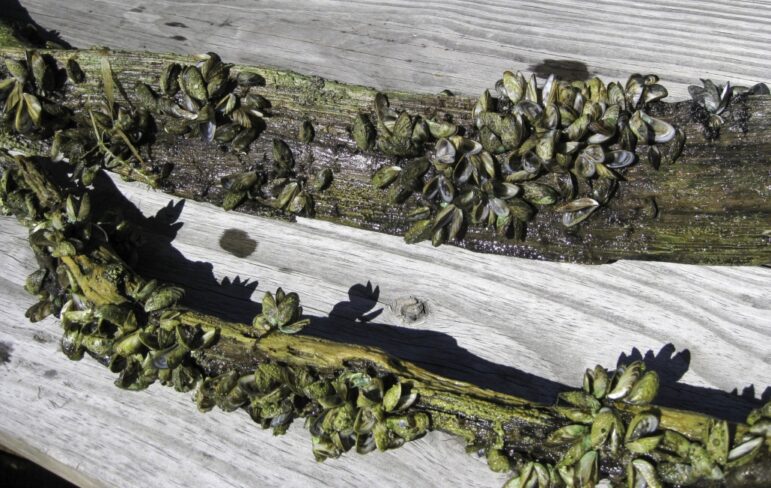By AMALIA MEDINA
Capital News Service
LANSING — Water tanks line a room in Philadelphia’s Water Works on the bank of the Schuylkill River. Inside are small fish that are hosts to tiny organisms that researchers say can help solve polluted waterways.
Tucked under the fish gills are microscopic mussels that will mature and become capable of filtering 10 to 15 gallons of water per day. Those data points make Lance Butler, who leads the research, hopeful.
In essence, mussels are “our canaries in the coal mine for our water,” he said.
Butler is among the group of scientists across the globe – including Southwest Michigan — looking toward such “blue infrastructure” to provide less expensive and more efficient systems to scrub contaminants from municipal wastewater. The role of native mussels in that fight may be crucial — but only if they survive competition with non-native invasive mussels in fresh water havens like the Great Lakes.
Invasive mussels have overtaken Midwest waterways since the 1980s. They’ve become a primary target in the fight against invasive species because they damage millions of dollars’ worth of infrastructure each year and impede recreation.
As states like Michigan crack down on the spread of invasive mussels, scientists are beginning to understand their impact on water quality.
At the size of a fingernail, they latch onto almost anything, including native mussels which die in the process.
Scientists are investigating both native and invasive species.
The invasives are successful because of their ability to colonize, said Stephen Hamilton, a retired Michigan State University freshwater ecologist.
And the sheer abundance of quagga and zebra mussels allows them clear out vast amounts of water, Butler said, adding that they’re such effective filterers that – if they were native – researchers would use them for wastewater treatment.
Hamilton has studied the effects of zebra mussels on a type of cyanobacteria called microcystis that can form harmful algal blooms. He co-authored a 2021 study that found a causal relationship between zebra mussels and microcystis.
The research began after scientists at the Kellogg Biological Station next to Gull Lake in Kalamazoo County noticed a decline in water quality.

Surprised to see increasing microcystic blooms in a lake with low phosphorus conditions, they theorized that the recent introduction of zebra mussels in Gull Lake was responsible.
“We decided to try to establish that connection to basically prove the hypothesis,” Hamilton said.
Researchers mounted 30-feet deep enclosures to floating rafts in the lake and put varying amounts of zebra mussels and phosphorus in each enclosure.
After finding a positive correlation between the mussels and microcystis blooms, they expanded the survey to other bodies of water across Michigan. They found that at lower phosphorus levels, lakes with zebra mussels had about three times more microcystis.
The team working in Philadelphia is evaluating the prospect of using mussels as biological indicators.
That practice ranges from assessing their tissue to find contaminants to using them to alert people to potential hazards. It’s already been implemented in Minneapolis where mussels were used to assess water quality in wastewater treatment plants.
Daelyn Woolnough of Central Michigan University’s Department of Biology and Institute for Great Lakes Research, explained the practice.
Woolnough said mussels close their filters when encountering poor water quality or potentially harmful contaminants. When they clam up, wires attached to their shells notify people to potential contaminants.
People can then run tests and pause the flow of water into lakes and rivers, Woolnough said.
In addition to wastewater, scientists are considering how mussels could be used in stormwater wetlands. Introducing mussels as a “pretreatment” before water enters a stream could result in streams receiving cleaner water, Butler said.
The studies are part of a growing approach toward sustainable solutions to climate issues, he said.
“There’s gray infrastructure, there’s green infrastructure – now we’re talking about blue infrastructure,” Butler said, “where you restore a system, where you create a system and you introduce biological systems that were here.”
Woolnough noted that although invasive mussels make water clear, that’s a far cry from making it clean.
In fact, if water becomes too clear, increased sun penetration can promote phosphorus and nitrogen, which leads to harmful algae growth.
Another key difference between invasive and native mussels is life cycle. Many native mussels live for 20 to 80 years, but zebra and quagga mussels live for just a few years.
When invasive mussels die, they release contaminants into the water column. But when native mussels die, they burrow underground, which Woolnough said is like burying the contaminants for free.
The downsides of invasive mussels highlight the importance of research focused on restoring native populations.
But that requires a delicate approach, and a solution should start on a small scale, Woolnough said.
Adding native mussels to an environment should augment existing populations, not create new ones, Woolnough and Hamilton said.
Amalia Medina was an environmental reporting intern under the MSU Knight Center for Environmental Journalism’s diversity reporting partnership with the Mott News Collaborative and in association with CNS. This story was produced for Circle of Blue.
The post Harnessing mussels to filter fresh water: A biological cure for contaminants is being studied appeared first on Spartan Newsroom.
Support City Pulse - Donate Today!
Comments
No comments on this item Please log in to comment by clicking here